Developing a Risk Management Process for Infrastructure Projects Using IDEF0
Abstract
:1. Introduction
2. Problem Statement
3. Research Objectives
4. Research Background and Literature Review
5. Methodology
IDEF0 Modeling for the Risk Management Process
6. System Implementation
6.1. Database Design
6.2. Database Design Process
6.3. Entity-Relationship Model
7. Case Study
7.1. Case Introduction
7.2. Risk Management in the Planning Stage of the MRT Project
- The Railway Bureau proposed a viaduct approach.
- The MRT Taipei City Government Bureau proposed an underground approach.
8. Conclusions
Author Contributions
Funding
Institutional Review Board Statement
Informed Consent Statement
Data Availability Statement
Conflicts of Interest
References
- Papanikolaou, M.; Xenidis, Y. Risk-Informed Performance Assessment of Construction Projects. Sustainability 2020, 12, 5321. [Google Scholar] [CrossRef]
- Jannadi, O.A.; Almishari, S. Risk Assessment in Construction. J. Constr. Eng. Manag. 2003, 129, 492. [Google Scholar] [CrossRef]
- Al Khattab, A.; Anchor, J.; Davies, E. Managerial perceptions of political risk in international projects. Int. J. Proj. Manag. 2007, 25, 734–743. [Google Scholar] [CrossRef] [Green Version]
- Elkington, P.; Smallman, C. Managing project risks: A case study from the utilities sector. Int. J. Proj. Manag. 2002, 20, 49–57. [Google Scholar] [CrossRef]
- Kim, M.-H.; Lee, E.-B.; Choi, H.-S. A Forecast and Mitigation Model of Construction Performance by Assessing Detailed Engineering Maturity at Key Milestones for Offshore EPC Mega-Projects. Sustainability 2019, 11, 1256. [Google Scholar] [CrossRef] [Green Version]
- Dikmen, I.; Birgonul, M.T.; Anac, C.; Tah, J.H.M.; Aouad, G. Learning from risks: A tool for post-project risk assessment. Autom. Constr. 2008, 18, 42–50. [Google Scholar] [CrossRef] [Green Version]
- Kartam, N.A.; Kartam, S.A. Risk and its management in the Kuwaiti construction industry: A contractors’ perspective. Int. J. Proj. Manag. 2001, 19, 325–335. [Google Scholar] [CrossRef]
- Tserng, H.P.; Yin, S.Y.L.; Dzeng, R.J.; Wou, B.; Tsai, M.D.; Chen, W.Y. A study of ontology-based risk management framework of construction projects through project life cycle. Autom. Constr. 2009, 18, 994–1008. [Google Scholar] [CrossRef]
- del Caño, A.; de la Cruz, M.P. Integrated Methodology for Project Risk Management. J. Constr. Eng. Manag. 2002, 128, 473. [Google Scholar] [CrossRef]
- Han, S.H.; Kim, D.Y.; Kim, H.; Jang, W.-S. A web-based integrated system for international project risk management. Autom. Constr. 2008, 17, 342–356. [Google Scholar] [CrossRef]
- Dang, P.; Niu, Z.; Gao, S.; Hou, L.; Zhang, G. Critical Factors Influencing the Sustainable Construction Capability in Prefabrication of Chinese Construction Enterprises. Sustainability 2020, 12, 8996. [Google Scholar] [CrossRef]
- Marques, G.; Gourc, D.; Lauras, M. Multi-criteria performance analysis for decision making in project management. Int. J. Proj. Manag. 2011, 29, 1057–1069. [Google Scholar] [CrossRef]
- Rosemann, M.; Green, P. Developing a meta model for the Bunge–Wand–Weber ontological constructs. Inf. Syst. 2002, 27, 75–91. [Google Scholar] [CrossRef]
- Legault, M.-J.; Chasserio, S. Professionalization, risk transfer, and the effect on gender gap in project management. Int. J. Proj. Manag. 2012, 30, 697–707. [Google Scholar] [CrossRef] [Green Version]
- Van Wyk, R.; Bowen, P.; Akintoye, A. Project risk management practice: The case of a South African utility company. Int. J. Proj. Manag. 2008, 26, 149–163. [Google Scholar] [CrossRef]
- Leśniak, A.; Janowiec, F. Risk Assessment of Additional Works in Railway Construction Investments Using the Bayes Network. Sustainability 2019, 11, 5388. [Google Scholar] [CrossRef] [Green Version]
- Ward, S.C.; Chapman, C.B. Risk-management perspective on the project lifecycle. Int. J. Proj. Manag. 1995, 13, 145–149. [Google Scholar] [CrossRef]
- Astarini, S.D.; Utomo, C. Performance-Based Building Design of High-Rise Residential Buildings in Indonesia. Sustainability 2020, 12, 7103. [Google Scholar] [CrossRef]
- Koulinas, G.; Demesouka, O.; Marhavilas, P.; Vavatsikos, A.; Koulouriotis, D. Risk Assessment Using Fuzzy TOPSIS and PRAT for Sustainable Engineering Projects. Sustainability 2019, 11, 615. [Google Scholar] [CrossRef] [Green Version]
- Marhavilas, P.K.; Tegas, M.G.; Koulinas, G.K.; Koulouriotis, D.E. A Joint Stochastic/Deterministic Process with Multi-Objective Decision Making Risk-Assessment Framework for Sustainable Constructions Engineering Projects—A Case Study. Sustainability 2020, 12, 4280. [Google Scholar] [CrossRef]
- Yang, Y.; Tang, W.; Shen, W.; Wang, T. Enhancing Risk Management by Partnering in International EPC Projects: Perspective from Evolutionary Game in Chinese Construction Companies. Sustainability 2019, 11, 5332. [Google Scholar] [CrossRef] [Green Version]
- Tserng, H.P.; Chang, D.W.; Chen, C.H.; Liu, Y.-H. Establishment of Risk Management Procedures and Information System of the MRT Project. MRT Technol. Biannu. 2011, 45, 137–150. [Google Scholar]
- Paté-Cornell, M.-E.; Kuypers, M.; Smith, M.; Keller, P. Cyber risk management for critical infrastructure: A risk analysis model and three case studies. Risk Anal. 2017, 38, 226–241. [Google Scholar] [CrossRef]
- Olsson, R. In search of opportunity management: Is the risk management process enough? Int. J. Proj. Manag. 2007, 25, 745–752. [Google Scholar] [CrossRef]
- Nawaz, A.; Waqar, A.; Shah, S.A.R.; Sajid, M.; Khalid, M.I. An innovative framework for risk management in construction projects in developing countries: Evidence from Pakistan. Risks 2019, 7, 24. [Google Scholar] [CrossRef] [Green Version]
- Tummala, V.; Schoenherr, T. Assessing and managing risks using the Supply Chain Risk Management Process (SCRMP). Supply Chain Manag. Int. J. 2011, 16, 474–483. [Google Scholar] [CrossRef]
- Firmenich, J. Customisable framework for project risk management. Constr. Innov. 2017, 17, 68–89. [Google Scholar] [CrossRef]
- Slagmulder, R.; Devoldere, B. Transforming under deep uncertainty: A strategic perspective on risk management. Bus. Horizons 2018, 61, 733–743. [Google Scholar] [CrossRef]
- Chatterjee, K.; Zavadskas, E.K.; Tamosaitiene, J.; Adhikary, K.; Kar, S. A hybrid MCDM technique for risk management in construction projects. Symmetry 2018, 10, 46. [Google Scholar] [CrossRef] [Green Version]
- Ozan, O.; Budayan, C.; Dikmen, I. A knowledge-based risk management tool for construction projects using case-based reasoning. Expert Syst. Appl. 2021, 173, 114776. [Google Scholar]
- Bandara, W.; Gable, G.G.; Tate, M.; Rosemann, M. A validated business process modelling success factors model. Bus. Process Manag. J. 2021. [CrossRef]
- Rosemann, M.; zur Muehlen, M. Integrating Risks in Business Process Models. 2005. ACIS 2005 Proceedings. Available online: https://aisel.aisnet.org/acis2005/50 (accessed on 30 November 2020).
- Lambert, J.H.; Jennings, R.K.; Joshi, N.N. Integration of risk identification with business process models. Syst. Eng. 2006, 9, 187–198. [Google Scholar] [CrossRef]
- Joseph, T.; Carr, V. Information modelling for a construction project risk management system. Eng. Constr. Archit. Manag. 2007, 7, 107–119. [Google Scholar]
- Gunduz, M.; Elsherbeny, H.A. Construction Contract Administration Performance Assessment Tool by Using a Fuzzy Structural Equation Model. Sustainability 2020, 12, 523. [Google Scholar] [CrossRef] [Green Version]
- Kuo, Y.-C.; Lu, S.-T. Using fuzzy multiple criteria decision making approach to enhance risk assessment for metropolitan construction projects. Int. J. Proj. Manag. 2013, 31, 602–614. [Google Scholar] [CrossRef]
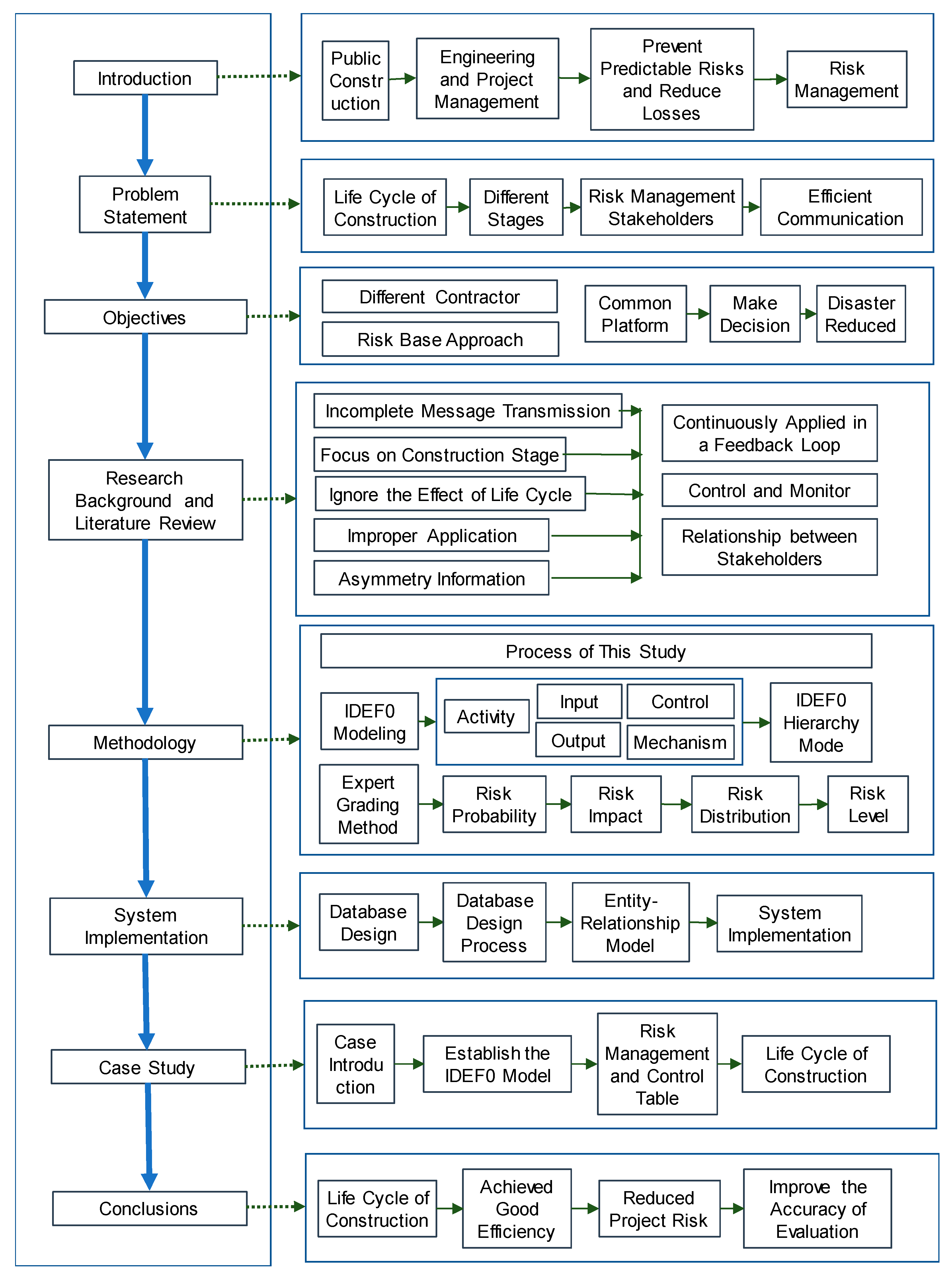
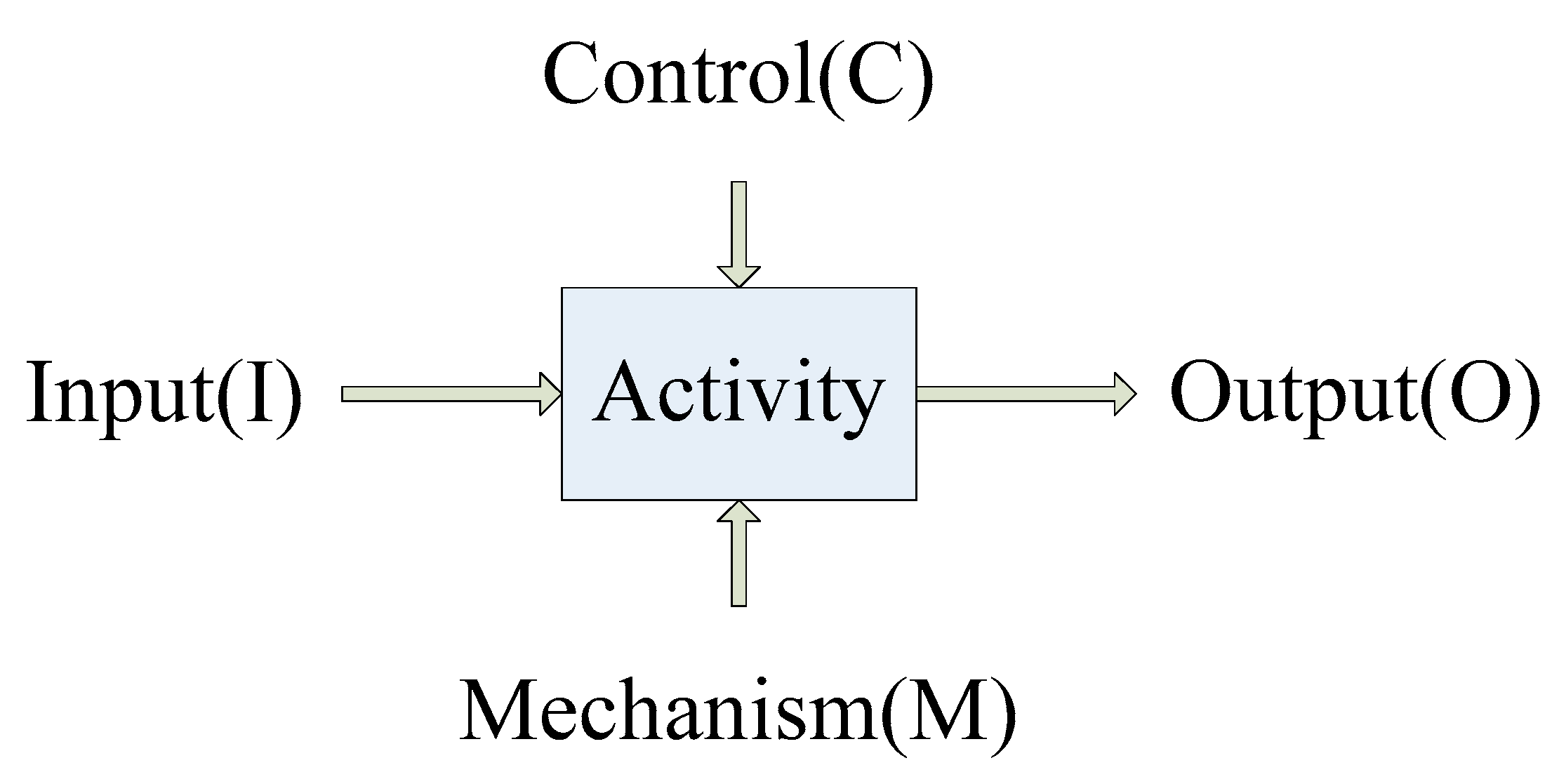

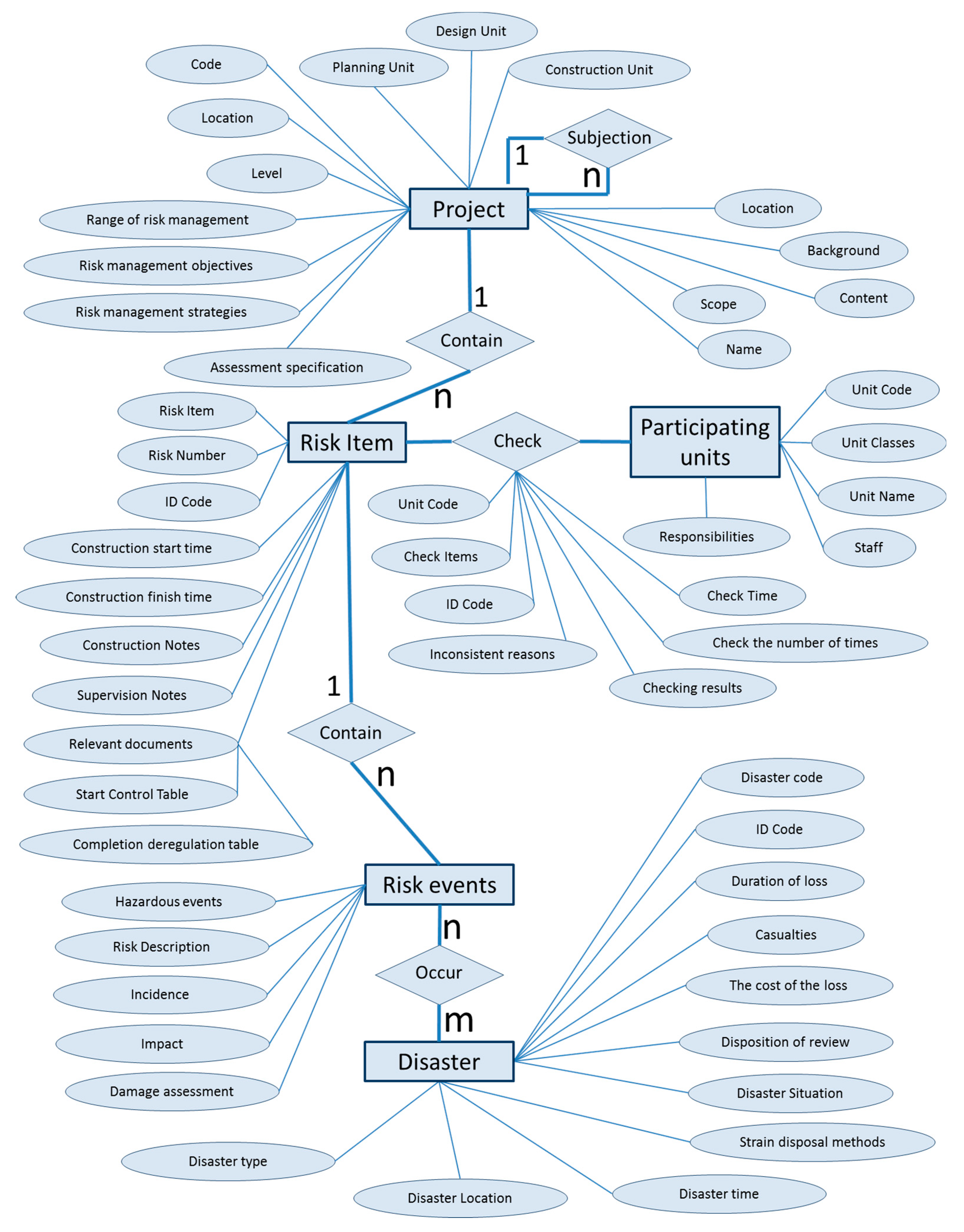
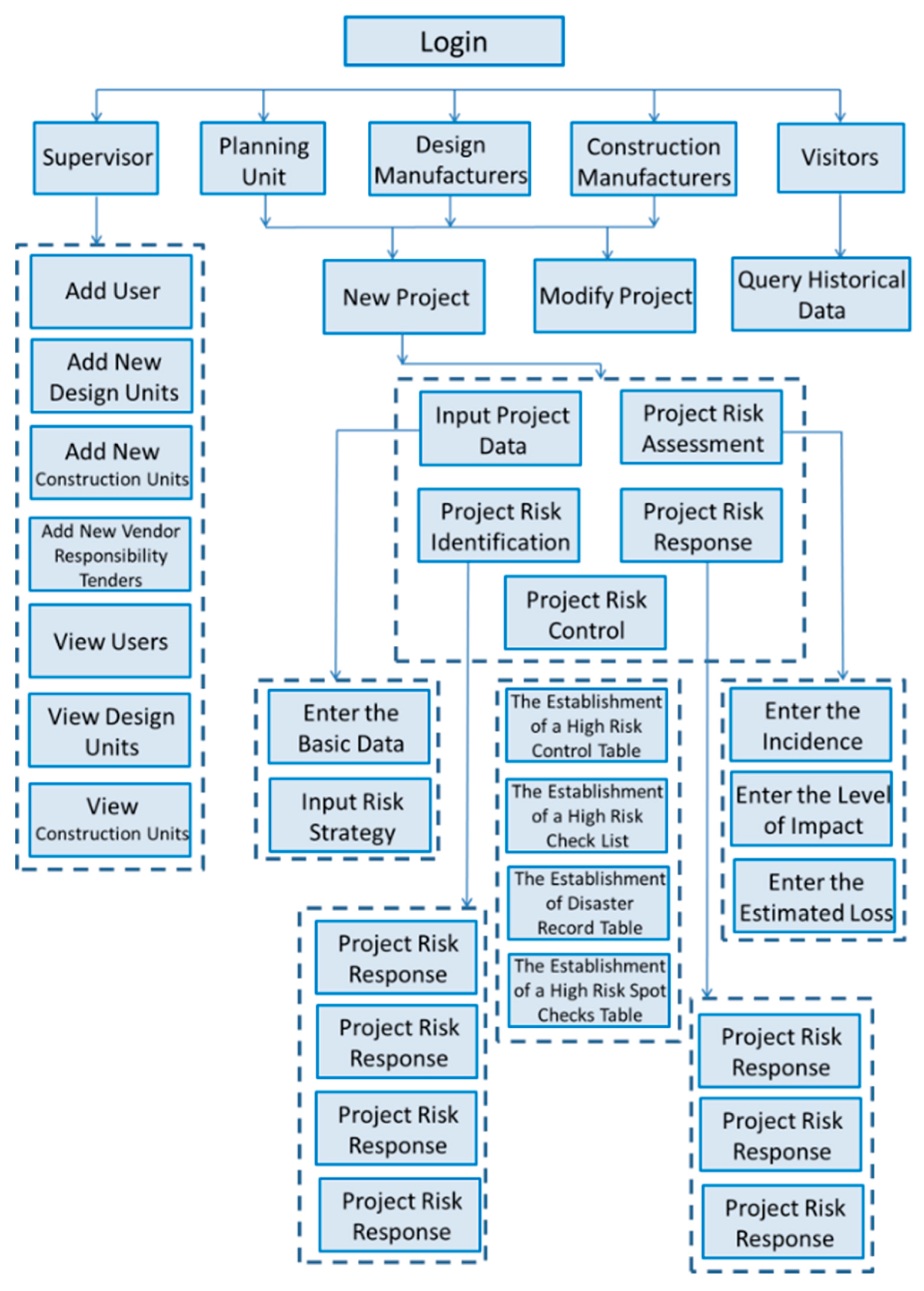
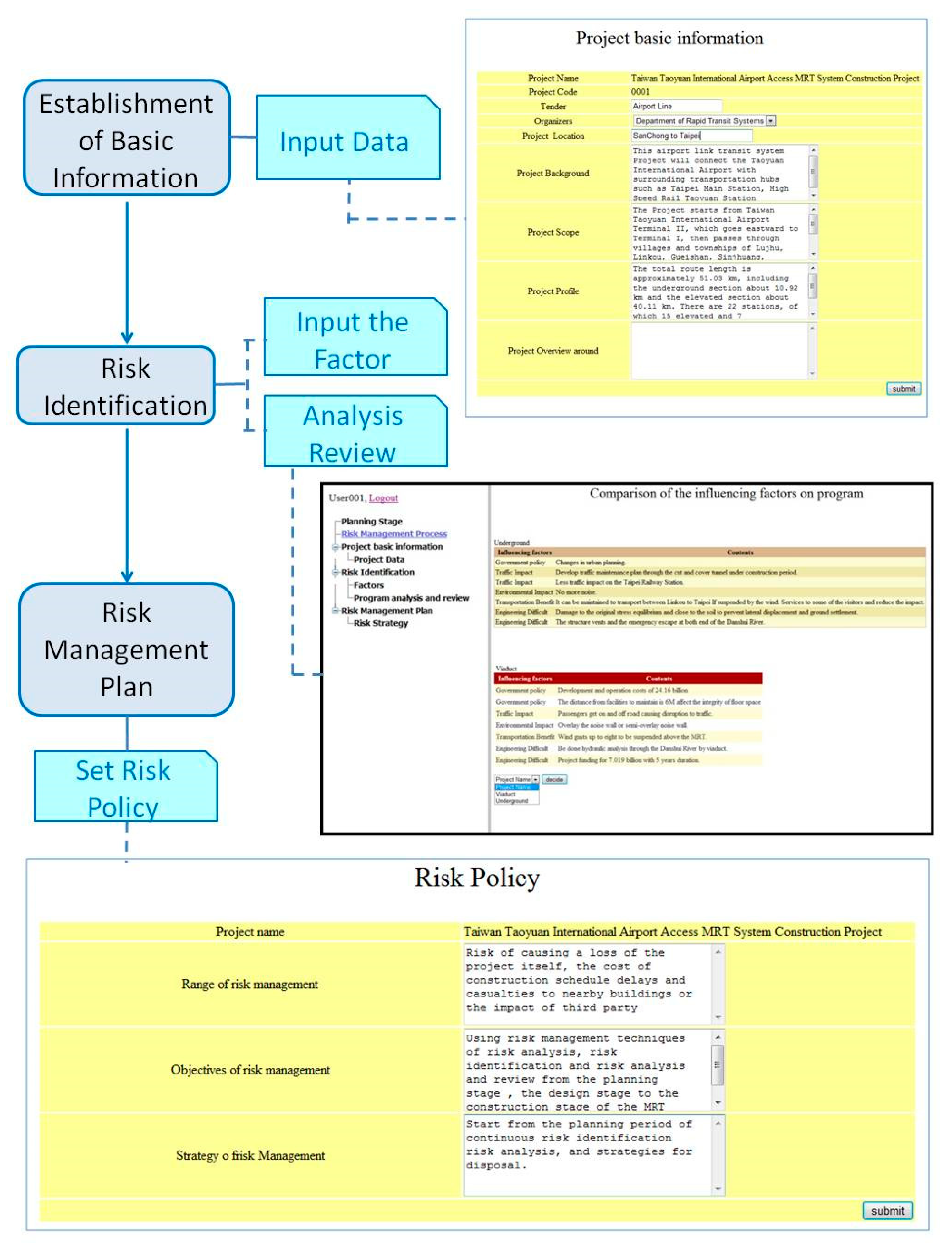
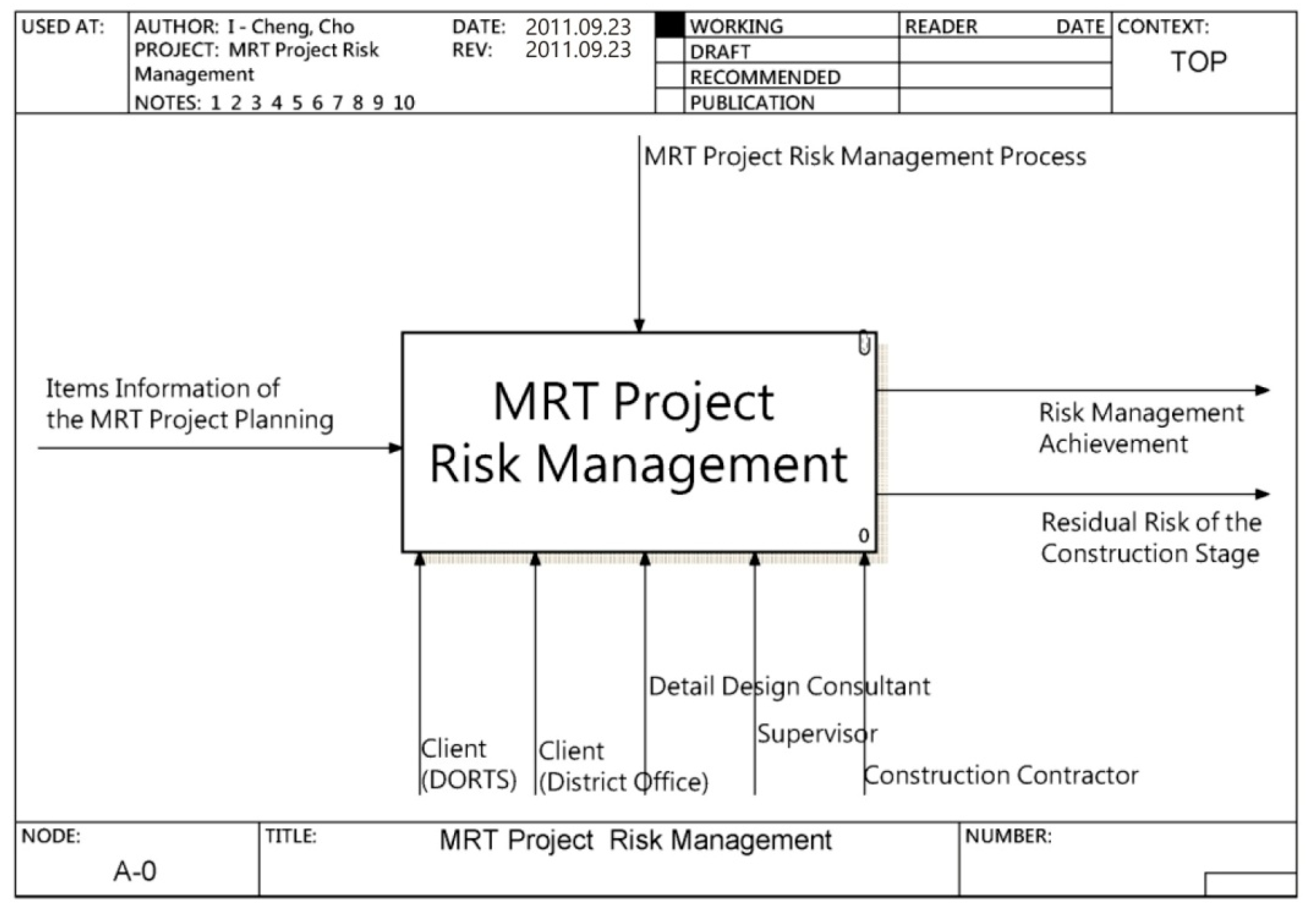
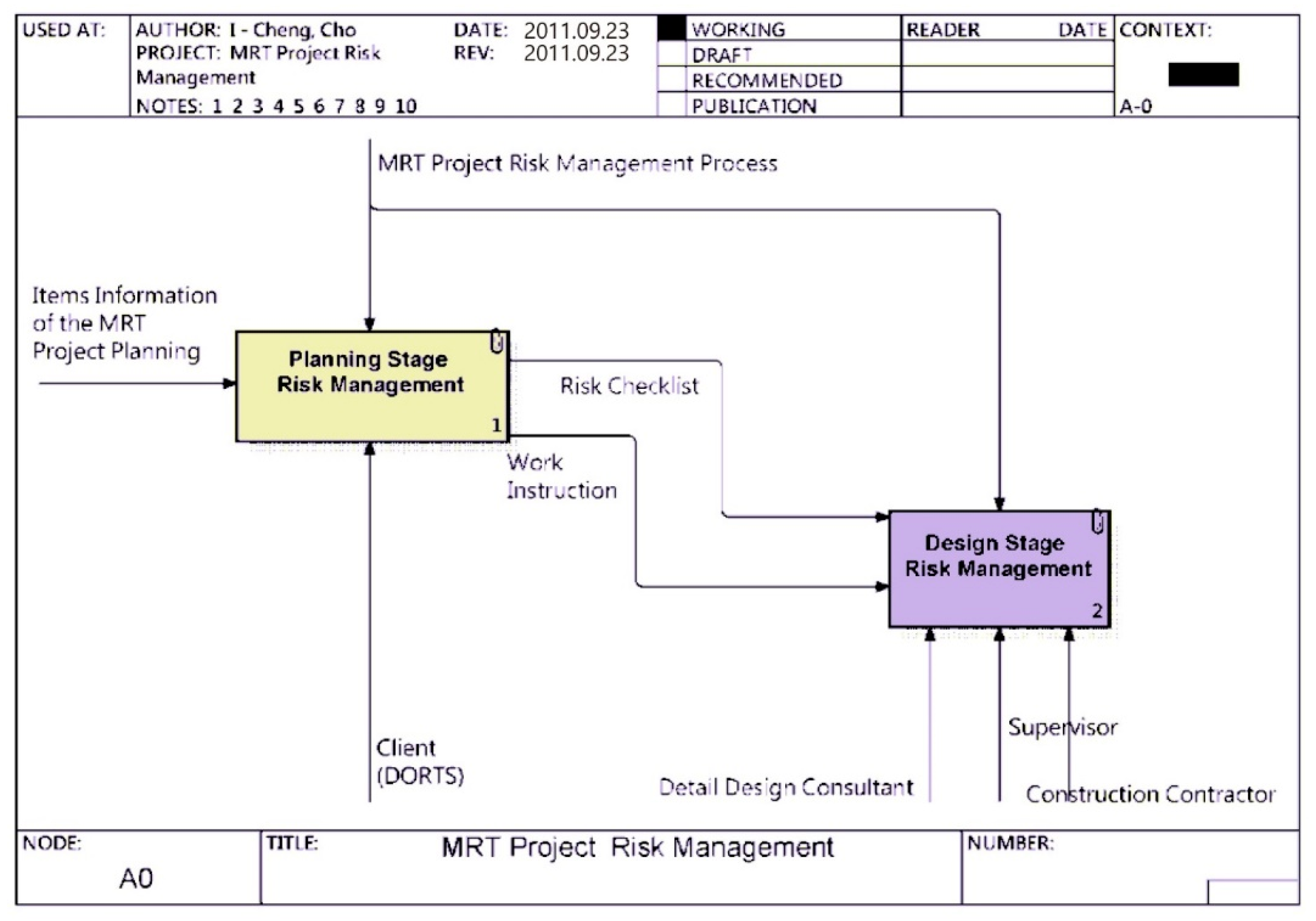
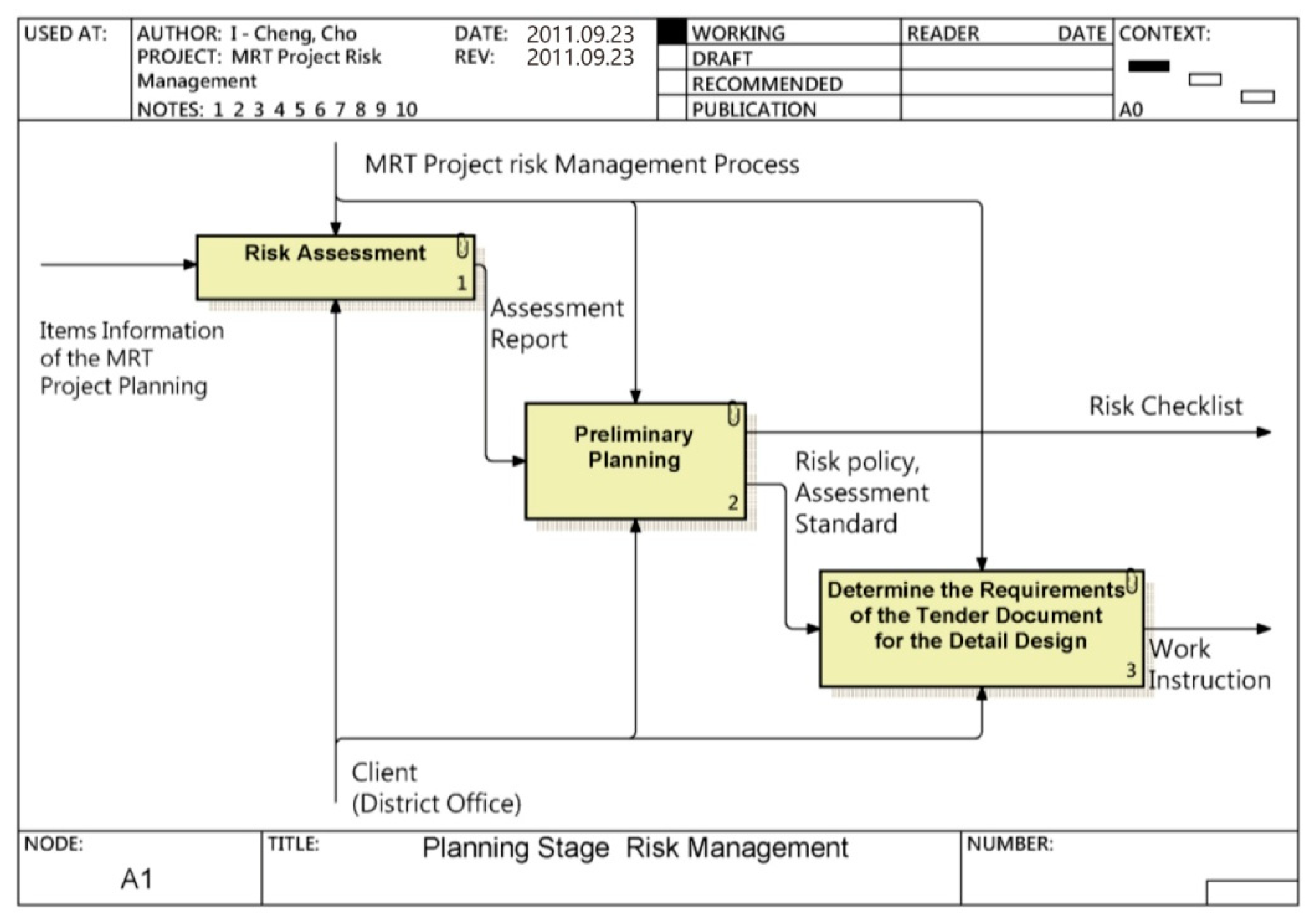
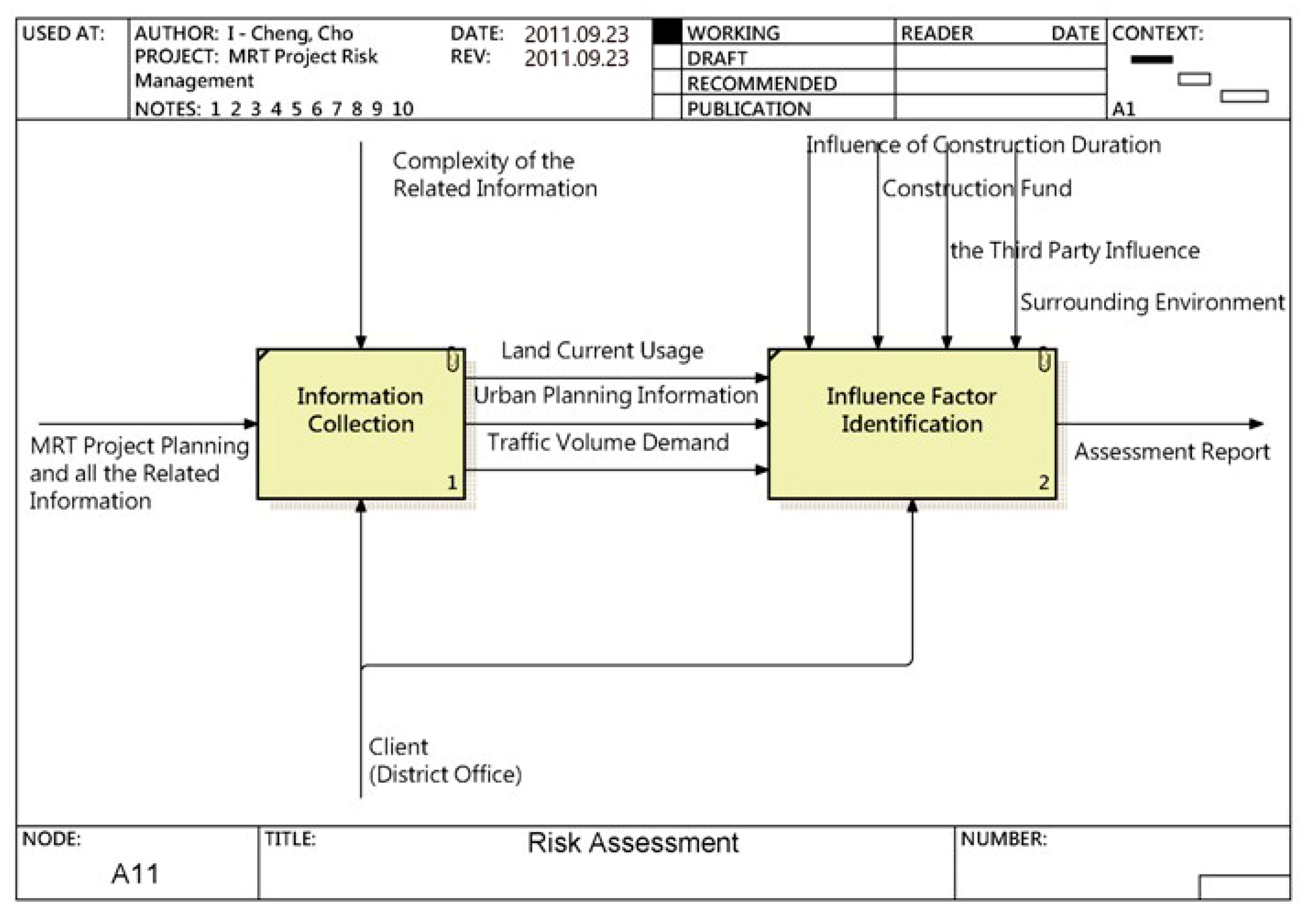
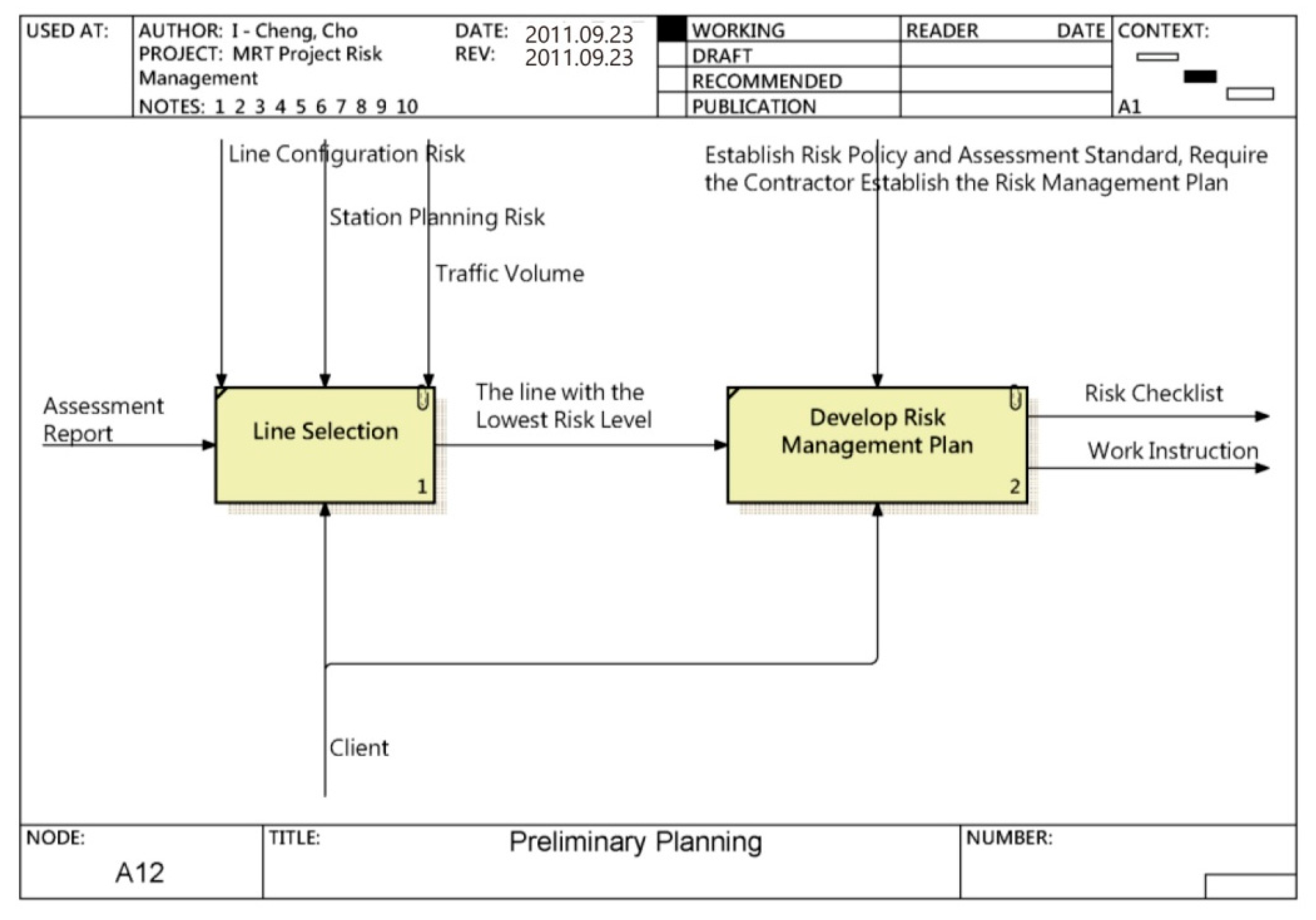

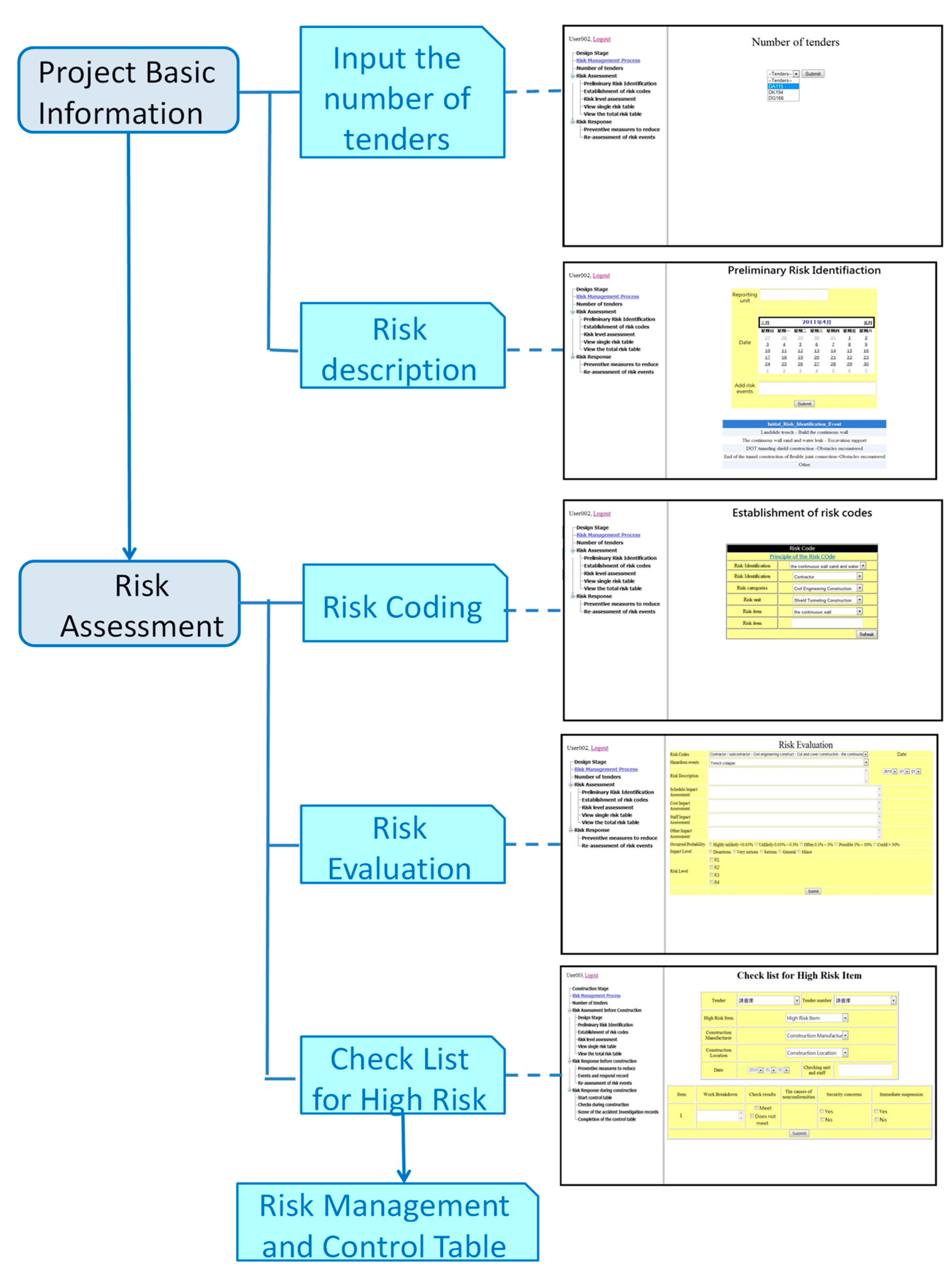
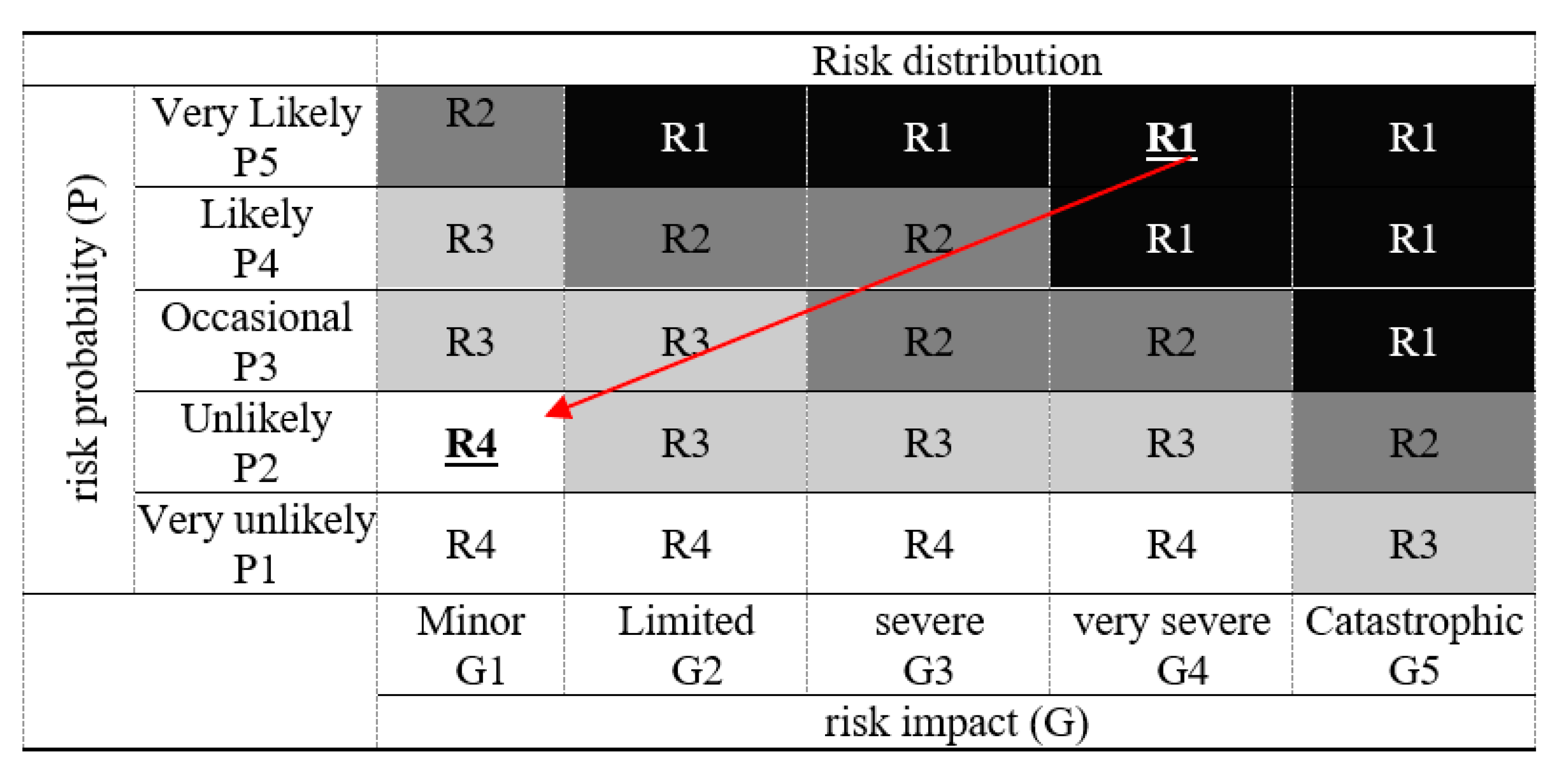
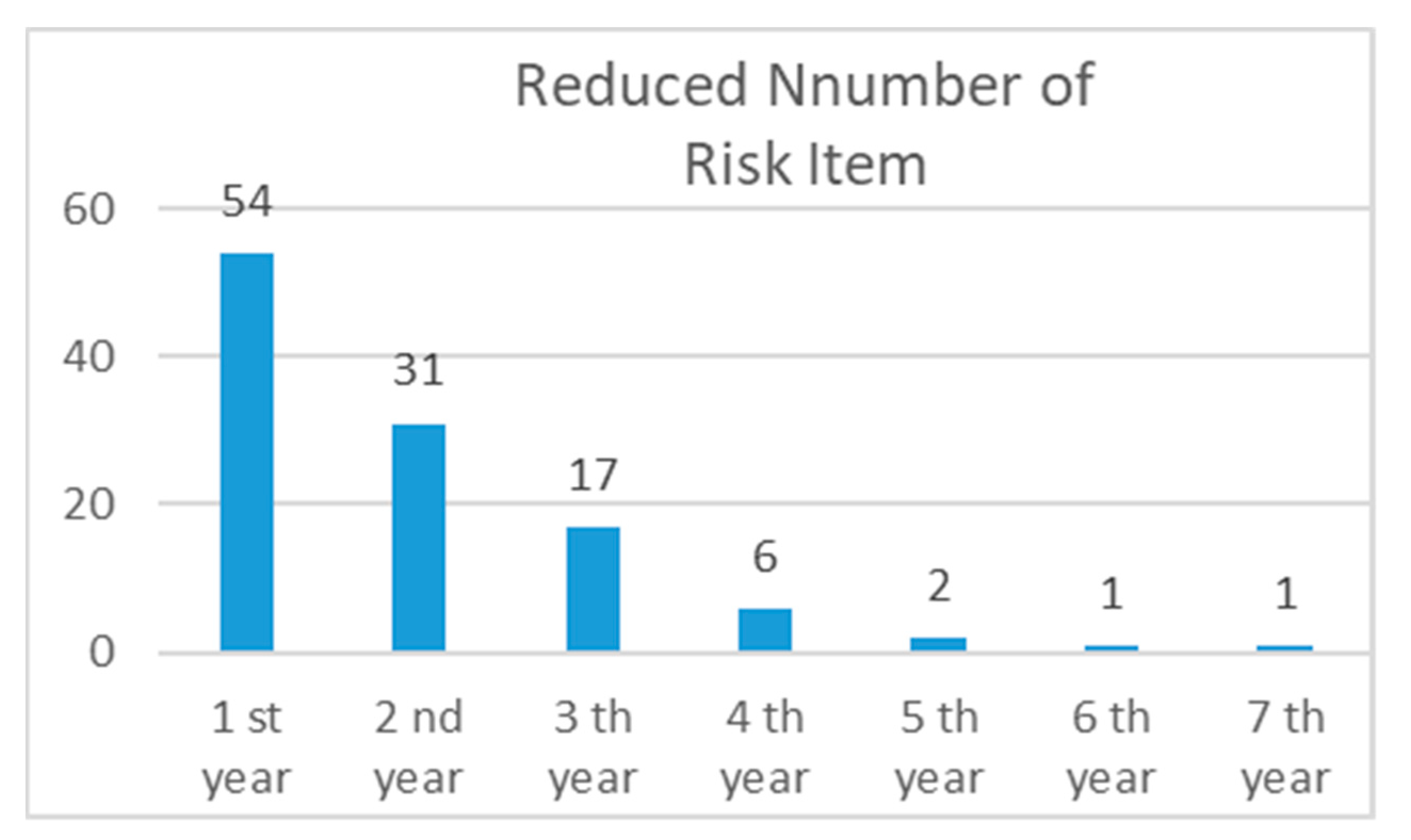
| Probability Classification | ||
|---|---|---|
| Classification | Indicators | Probability |
| Very likely | P5 | >0.3 |
| Likely | P4 | 0.03–0.3 |
| Occasional | P3 | 0.003–0.03 |
| Unlikely | P2 | 0.0003–0.003 |
| Very unlikely | P1 | <0.0003 |
| Consequence Classification Table | |||||
|---|---|---|---|---|---|
| Impact Levels | |||||
| Risk Impact | Catastrophic G5 | Very Severe G4 | Severe G3 | Limited G2 | Minor G1 |
| Injury or death during project or project failure | F > 10 | 1 < F ≤ 10 SI > 10 | 1F 1 < SI ≤ 10 | 1SI 1 < MI ≤ 10 | 1MI |
| Adverse impact on project schedule | >24 months | 6–24 months | 2–6 months | 1/2–2 months | <1/2 months |
| The ratio of the business’ financial loss to the total project cost | >33% | 3.3–33% | 0.33–3.3% | 0.03–0.33% | 0.003–0.03% |
| Risk Distribution | ||||||
|---|---|---|---|---|---|---|
| Risk Impact (G) | ||||||
| Minor G1 | Limited G2 | Severe G3 | Very Severe G4 | Catastrophic G5 | ||
| Risk probability (P) | Very Likely P5 | R2 | R1 | R1 | R1 | R1 |
| Likely P4 | R3 | R2 | R2 | R1 | R1 | |
| Occasional P3 | R3 | R3 | R2 | R2 | R1 | |
| Unlikely P2 | R4 | R3 | R3 | R3 | R2 | |
| Very unlikely P1 | R4 | R4 | R4 | R4 | R3 | |
| Risk Level Standard | ||
|---|---|---|
| Risk Level | Countermeasures | |
| R1 | Unacceptable | Should not be included in project design, risk measures to be taken to reduce risk |
| R2 | Marginally acceptable | Risk mitigation measures to be taken |
| R3 | Acceptable | Include in the risk management process |
| R4 | Ignorable | Do not need to respond to this risk |
| Item | First Level | Second Level | Third Level |
|---|---|---|---|
| A0 MRT Project Risk Management | A1 Planning Stage Risk Management | A11 Risk assessment | A111 Information collection |
| A112 Influence factor identification | |||
| A12 Preliminary planning | A121 Line selection | ||
| A122 Development of risk management plan | |||
| A13 Determination of requirements for the tender document for the detailed design | A131 Establishment of detailed design standard | ||
| A132 Preparation of the detailed design tender document | |||
| A133 Assessment selection on the detail design consultant |
| Node | No. | Stage Name | Input | Output | Control | Mechanism |
|---|---|---|---|---|---|---|
| A1 | 1 | Risk assessment | Information on items of the MRT project planning | Assessment report | MRT Project risk management process | Client |
| A1 | 2 | Preliminary planning | Assessment report | Risk checklist, risk policy, and assessment standard | MRT Project risk management process | Client |
| A1 | 3 | Determination of the requirements for the tender document for the detailed design | Risk policy and assessment standard | Work instruction | MRT Project risk management process | Client |
| A11 | 1 | Information collection | MRT project planning and all related information | Current land usage, urban planning information, and traffic volume demand | Complexity of the related information | Client |
| A11 | 2 | Influence factor identification | Current land usage, urban planning information and traffic volume demand | Assessment report | Influence of construction duration and construction fund, third-party influences, surrounding environment | Client |
| A12 | 1 | Line selection | Assessment report | The line with the lowest risk level, risk checklist | Line configuration risk, station planning risk | Client |
| A12 | 2 | Development of risk management plan | The line with the lowest risk level | Work instruction | Establish risk policy and assessment standard, require the contractor establish the risk management plan | Client |
| A13 | 1 | Establishment of detailed design standard | Risk policy and assessment standard | Work scope, design standard | Divide the risk into general and special groups | Client |
| A13 | 2 | Preparation of the detailed design tender document | Work scope | Tender-related documents | Ensure the detailed design consultant has the technique to reduce the risk level and relevant risk management experience | Client |
| A13 | 3 | Assessment selection of the detailed design consultant | Tender-related documents | Selection methods | Ensure the detail design consultant has the technique to reduce the risk level and relevant risk management experience | Client |
| Preliminary Risk Identification: Detailed List | |||
|---|---|---|---|
| Project | DA115 | Report Unit | Risk Management Team |
| No. | Risk Event | ||
| 1 | The investigation has inadequate funding and a tight schedule | ||
| 2 | Stakeholder requirements for content is not clear | ||
| 3 | Requirements for the implementation of the phase process is not clear | ||
| 4 | Design quality and schedule management | ||
| No. | Risk Item | Original Risk Probability | Original Risk Impact | Original Risk Levels | Final Risk Probability | Final Risk Impact | Final Risk Levels |
|---|---|---|---|---|---|---|---|
| 1 | Insufficient funding for surveying and tight schedule | P5 | G4 | R1 | P2 | G1 | R4 |
| 2 | Unclear stakeholder requirements | P4 | G4 | R1 | P1 | G1 | R4 |
| 3 | Unclear scheduling requirements | P4 | G4 | R1 | P2 | G1 | R4 |
| 4 | Poor design quality and progress management | P4 | G3 | R2 | P1 | G1 | R4 |
Publisher’s Note: MDPI stays neutral with regard to jurisdictional claims in published maps and institutional affiliations. |
© 2021 by the authors. Licensee MDPI, Basel, Switzerland. This article is an open access article distributed under the terms and conditions of the Creative Commons Attribution (CC BY) license (https://creativecommons.org/licenses/by/4.0/).
Share and Cite
Tserng, H.-P.; Cho, I.-C.; Chen, C.-H.; Liu, Y.-F. Developing a Risk Management Process for Infrastructure Projects Using IDEF0. Sustainability 2021, 13, 6958. https://doi.org/10.3390/su13126958
Tserng H-P, Cho I-C, Chen C-H, Liu Y-F. Developing a Risk Management Process for Infrastructure Projects Using IDEF0. Sustainability. 2021; 13(12):6958. https://doi.org/10.3390/su13126958
Chicago/Turabian StyleTserng, Hui-Ping, I-Cheng Cho, Chun-Hung Chen, and Yu-Fan Liu. 2021. "Developing a Risk Management Process for Infrastructure Projects Using IDEF0" Sustainability 13, no. 12: 6958. https://doi.org/10.3390/su13126958
APA StyleTserng, H.-P., Cho, I.-C., Chen, C.-H., & Liu, Y.-F. (2021). Developing a Risk Management Process for Infrastructure Projects Using IDEF0. Sustainability, 13(12), 6958. https://doi.org/10.3390/su13126958






